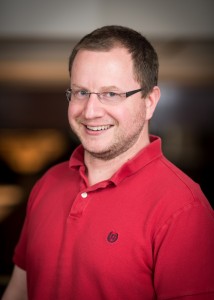|
This page was exported from King Weekly Sentinel
[ https://kingsentinel.com ] Export date: Sat Apr 5 10:56:26 2025 / +0000 GMT |
King scientist exploring the fundamentalsBy Mark Pavilons We are often encouraged to see the big picture  , but the answers to some fundamental questions are found at the microscopic level. , but the answers to some fundamental questions are found at the microscopic level.A King City biochemist will tell you the secrets centre around molecular interactions, and directing incredibly specific antibodies to their tiny targets. Transcribing the Bible on the head of a pin is child's play in comparison to unlocking the keys to slowing or curing degenerative or fatal diseases. Derek Wilson is an Associate Professor and Director of the Centre for Research in Mass Spectrometry at York University. He is the face of the current batch of Canadian academic research scientists – young, intelligent and dedicated. He's also a typical family man. His series of successes are as interrelated as his research. Instead of a single “eureka” or definitive cure, Derek's team of 13 students, graduates and post-doctoral fellows, has set in motion of pattern of incremental steps that will set the stage for further breakthroughs. And that's exciting, at every level. Wilson stressed they're doing “true science,” exploring nature at the most basic level, delving into the fascinating roles, interactions and mutations of protein molecules in our bodies. And they've reached their incremental end goals, making significant progress on the big questions along the way. In order to study the molecules, Wilson and his team had to create the efficient technology to do so. The typical way to examine molecules is through x-ray crystalography, but that only captures a still image. In the cell, proteins are constantly in motion! The Wilson team's first major success was the creation of a microfluidic chip, a small, contained and controlled environment that allows them to catch proteins in action, witnessing directly the transformations that drive life at the molecular level. This is vitally important to the unique type of research they do, and it set the stage for all of their subsequent explorations. Setting out with their new tool to explore molecular level biology, Wilson and his team labelled protein molecules to understand how they fold and “misfold” in Alzheimer's, Parkinson's and other neurodegenerative diseases. Their target was so called “disordered” proteins, which make up almost 20% of the total protein content in the human body, and play important roles in biology and disease. But they can't be studied by normal methods because they don't “fold up” unto a well-defined “native” structure. Using their device, Wilson and his team were able to precisely map the changes in structural bias that convert a protein called Tau from an important player in maintaining neurons in the brain, to a pathogenic actor in Alzheimer's. Knowing what this “bias transition” looks like is a critical step towards finding drugs that specifically interfere with Tau's dark side, and one more step towards a potential cure for a host of neurodegenerative diseases. But Wilson's work doesn't stop at neurodegeneration. Partnering with Dr. Patrick Gunning at U of T Mississauga, Wilson and his team have explored the action of drugs targeted to a protein called STAT3, one of the most critical targets in cancer research. In cancer, STAT3 erroneously gets a phosphate molecule stuck to it, at which point it goes into the nucleus (the control centre of the cell) and turns on every survival signal imaginable. This makes cancer cells with phosphorylated STAT3 exceptionally difficult to kill with chemotherapy. Wilson looked at how two drug candidate molecules supplied by Gunning interacted with STAT3. Not only did they achieve their principle goal of identifying specifically where these drugs were binding, but they also solved a mystery that had perplexed the Gunning team and others: One of the molecules bound much more weakly than the other one, but was almost exactly as effective at preventing STAT3 phosphorylation. Dr. Wilson's work showed that the weaker-binding molecule was turning on a whole range of molecular “switches” left untouched by the tighter-binding molecule. Not only did this explain why the weaker binding molecule was as effective as it was, it also pointed to the existence of a totally new, and previously unknown “activity pathway” for STAT3. More recently, Dr. Wilson and his team has been working with Canada's biopharmaceuticals industry to develop improved techniques that enable drug development. Pharmaceutical companies are currently facing a challenge, switching from their usual small molecule drugs to massive biological macromolecules like proteins. This has created a number of new challenges that Dr. Wilson's expertise and technologies can address. His industrial partners include Sanofi-Pasteur, a multinational - but Canada-based vaccine development company; Sciex a Canada-founded scientific instrument manufacturer, and Fludigm Canada, another Canadian company with unique bioanalytical technologies. “We're tackling ever-more complicated challenges,” Dr. Wilson said. “But luckily in Canada, we've got the new technologies and young dynamic scientists to do it.” And with those dedicated to fundamentals who can also translate their work to industrial applications, ultimate success in solving the most difficult of challenges is only a matter of time. |
| Excerpt: We are often encouraged to see the big picture, but the answers to some fundamental questions are found at the microscopic level. |
|
Post date: 2015-11-25 09:44:33 Post date GMT: 2015-11-25 14:44:33 Post modified date: 2015-12-22 09:45:07 Post modified date GMT: 2015-12-22 14:45:07 |
| Powered by [ Universal Post Manager ] plugin. HTML saving format developed by gVectors Team www.gVectors.com |